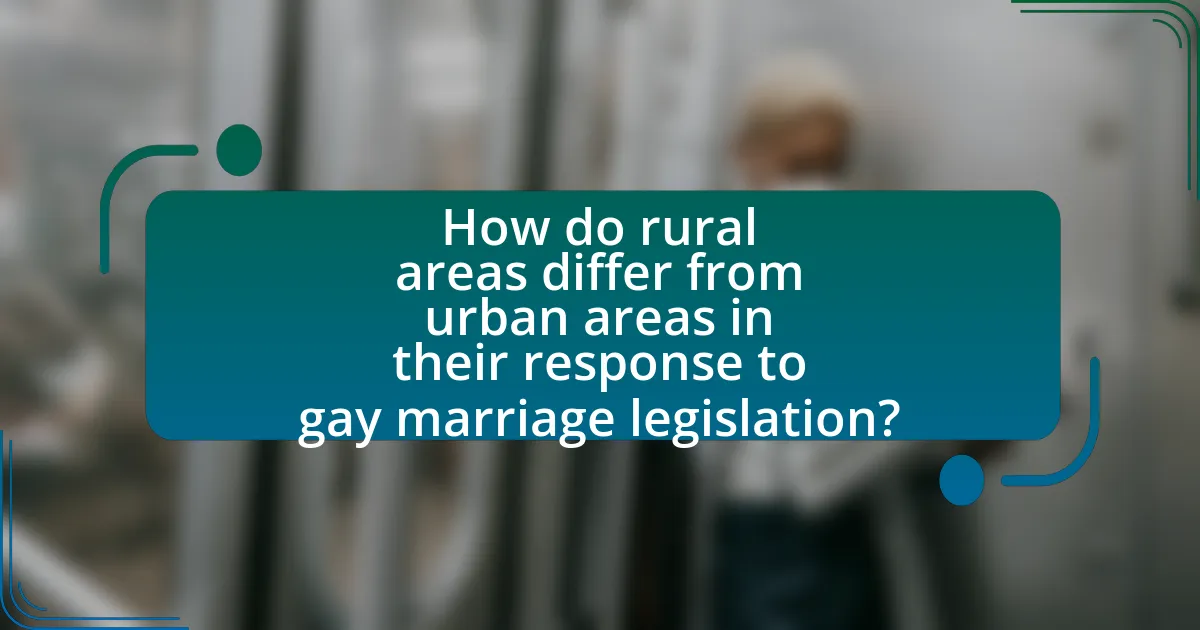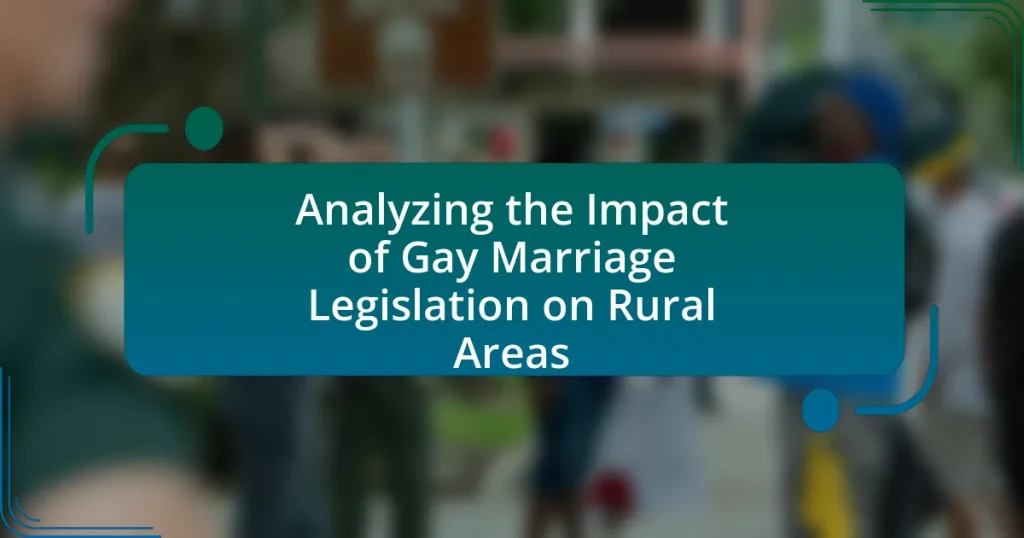The article analyzes the impact of gay marriage legislation on rural areas, highlighting its effects on social acceptance, economic growth, and community dynamics. It discusses the evolution of gay marriage laws in these regions, influenced by historical factors and cultural attitudes, and examines the social implications, including improved mental health outcomes for LGBTQ+ individuals. Additionally, the article addresses the role of local governance in implementing these laws, the economic benefits associated with increased tourism and local spending, and the challenges rural communities face in fostering inclusivity. It concludes by outlining strategies for promoting LGBTQ+ rights and creating supportive environments in rural settings.

What is the Impact of Gay Marriage Legislation on Rural Areas?
The impact of gay marriage legislation on rural areas includes increased acceptance and visibility of LGBTQ+ individuals, which can lead to enhanced community cohesion and economic benefits. Studies indicate that legalizing same-sex marriage has contributed to a more inclusive environment, fostering social acceptance and reducing stigma. For instance, research from the Williams Institute shows that states legalizing gay marriage experienced a boost in tourism and local economies, as LGBTQ+ individuals and allies are more likely to visit or relocate to areas perceived as welcoming. Additionally, rural areas that embrace such legislation often see improved mental health outcomes among LGBTQ+ residents, as acceptance can reduce isolation and discrimination.
How has gay marriage legislation evolved in rural areas?
Gay marriage legislation in rural areas has evolved significantly, particularly following the landmark Supreme Court decision in Obergefell v. Hodges in 2015, which legalized same-sex marriage nationwide. This ruling prompted many rural states to adapt their laws to comply with federal mandates, leading to increased acceptance and legal recognition of same-sex marriages in communities that historically held conservative views. For instance, states like North Carolina and Indiana, which have substantial rural populations, saw local governments and officials begin to implement marriage licenses for same-sex couples shortly after the ruling, reflecting a shift in both legal frameworks and social attitudes. Additionally, surveys indicate that public support for gay marriage has grown in rural areas, with a 2021 Gallup poll showing that 70% of Americans in rural regions now support same-sex marriage, up from 40% in 2004. This evolution illustrates a broader trend of changing perceptions and legal frameworks surrounding gay marriage in rural contexts.
What historical factors influenced the acceptance of gay marriage in rural communities?
The acceptance of gay marriage in rural communities has been influenced by several historical factors, including shifts in societal attitudes, legal precedents, and the impact of local activism. Over the past few decades, changing perceptions of LGBTQ+ rights, particularly following the decriminalization of homosexuality in many regions during the late 20th century, have contributed to greater acceptance. Legal milestones, such as the U.S. Supreme Court’s decision in Obergefell v. Hodges in 2015, which legalized same-sex marriage nationwide, also played a crucial role in normalizing gay relationships in rural areas. Additionally, grassroots movements and local advocacy efforts have fostered dialogue and understanding, leading to increased visibility and acceptance of LGBTQ+ individuals within these communities.
How do cultural attitudes in rural areas shape the response to gay marriage legislation?
Cultural attitudes in rural areas significantly influence the response to gay marriage legislation, often leading to resistance or support based on prevailing social norms. In many rural communities, traditional values and conservative beliefs dominate, resulting in opposition to gay marriage as it is perceived to conflict with established cultural and religious norms. For instance, a 2019 study by the Pew Research Center found that rural residents in the United States are more likely to oppose same-sex marriage compared to their urban counterparts, reflecting a broader trend where cultural conservatism shapes legislative attitudes. This resistance can manifest in local political actions, such as lobbying against legislation or supporting candidates who oppose gay marriage, thereby impacting the overall acceptance and implementation of such laws in rural settings.
What are the social implications of gay marriage legislation in rural areas?
Gay marriage legislation in rural areas can lead to increased social acceptance and visibility of LGBTQ+ individuals, fostering a more inclusive community. This shift often results in reduced stigma and discrimination, as legal recognition of same-sex marriages encourages dialogue and understanding among residents. For instance, studies have shown that areas with legalized gay marriage experience a decline in hate crimes and an increase in supportive community events, indicating a positive social transformation. Furthermore, the presence of legal protections can enhance mental health outcomes for LGBTQ+ individuals, as they feel more validated and supported within their communities.
How does gay marriage legislation affect community dynamics in rural settings?
Gay marriage legislation positively affects community dynamics in rural settings by fostering inclusivity and reducing stigma against LGBTQ+ individuals. Research indicates that the legalization of same-sex marriage leads to increased acceptance and visibility of LGBTQ+ relationships, which can enhance social cohesion within communities. For instance, a study published in the American Journal of Public Health found that states that legalized same-sex marriage experienced a significant decrease in suicide rates among LGBTQ+ youth, suggesting improved mental health outcomes and community support. This shift can lead to stronger community ties as diverse family structures become more recognized and accepted, ultimately contributing to a more unified and supportive rural environment.
What role does local governance play in the implementation of gay marriage laws?
Local governance plays a crucial role in the implementation of gay marriage laws by overseeing the administration of marriage licenses and ensuring compliance with state and federal regulations. Local authorities, such as county clerks and municipal offices, are responsible for processing marriage applications, which includes verifying eligibility and issuing licenses to same-sex couples. For instance, after the Supreme Court’s decision in Obergefell v. Hodges in 2015, local governments were tasked with updating their procedures and training staff to accommodate same-sex marriages, reflecting the legal changes mandated at higher levels of government. This local engagement is essential for the effective realization of gay marriage rights, as it directly impacts the accessibility and acceptance of these laws within rural communities.
What economic effects does gay marriage legislation have on rural areas?
Gay marriage legislation positively impacts rural areas economically by increasing local spending and boosting tourism. Studies indicate that states legalizing same-sex marriage experience a rise in wedding-related expenditures, which benefits local businesses such as venues, catering, and hospitality services. For instance, a report from the Williams Institute estimated that legalizing same-sex marriage in states like Iowa generated approximately $12 million in economic activity within the first year. Additionally, rural areas may attract LGBTQ+ tourists seeking inclusive destinations, further enhancing local economies.
How does the legalization of gay marriage impact local businesses in rural communities?
The legalization of gay marriage positively impacts local businesses in rural communities by increasing customer bases and stimulating economic growth. Studies indicate that areas with legalized same-sex marriage experience a rise in wedding-related spending, which benefits local vendors such as florists, caterers, and venues. For instance, a report by the Williams Institute found that same-sex weddings contribute approximately $1.6 billion annually to the U.S. economy, with rural areas seeing a notable share of this spending. Additionally, the acceptance fostered by legalization can enhance community cohesion, attracting more visitors and potential residents, further benefiting local economies.
What are the potential changes in property values following the legalization of gay marriage?
The potential changes in property values following the legalization of gay marriage can include an increase in property values in areas that become more inclusive and attractive to diverse populations. Research indicates that regions with legalized same-sex marriage often experience a rise in demand for housing, as LGBTQ+ individuals and couples seek to settle in communities that support their rights. For instance, a study by the Williams Institute found that states legalizing same-sex marriage saw a 10% increase in home prices over a five-year period compared to states that did not legalize it. This trend suggests that the legalization of gay marriage can positively influence property values, particularly in rural areas that embrace inclusivity.

How do rural areas differ from urban areas in their response to gay marriage legislation?
Rural areas typically exhibit more resistance to gay marriage legislation compared to urban areas, which tend to show greater acceptance. This difference is often attributed to cultural values, religious beliefs, and social norms prevalent in rural communities, where traditional views on marriage are more deeply rooted. For instance, a 2019 study by the Pew Research Center found that 61% of urban residents supported same-sex marriage, while only 45% of rural residents expressed similar support. This disparity highlights the contrasting attitudes towards gay marriage legislation between these two types of communities.
What unique challenges do rural areas face regarding gay marriage acceptance?
Rural areas face unique challenges regarding gay marriage acceptance primarily due to deeply rooted cultural and religious beliefs that often oppose LGBTQ+ rights. These communities tend to have less exposure to diverse perspectives, leading to a lack of understanding and acceptance of gay marriage. For instance, a 2019 study by the Williams Institute found that rural residents are significantly less likely to support same-sex marriage compared to their urban counterparts, with only 43% of rural respondents in favor, compared to 65% in urban areas. Additionally, social isolation in rural settings can exacerbate stigma, as individuals may fear ostracism or backlash from their communities for expressing support for gay marriage. This combination of cultural conservatism and social isolation creates a challenging environment for the acceptance of gay marriage in rural areas.
How do demographic differences influence attitudes towards gay marriage in rural areas?
Demographic differences significantly influence attitudes towards gay marriage in rural areas, with factors such as age, education, and religious affiliation playing crucial roles. Younger individuals tend to show more acceptance of gay marriage compared to older generations, as evidenced by surveys indicating that 70% of adults aged 18-29 support gay marriage, while only 40% of those aged 65 and older do. Additionally, higher levels of education correlate with more favorable views on gay marriage; for instance, college graduates are more likely to support it than those with only a high school diploma. Furthermore, religious beliefs heavily impact attitudes, as individuals from more conservative religious backgrounds often oppose gay marriage, reflecting broader societal norms in rural communities. These demographic factors collectively shape the prevailing attitudes towards gay marriage in these areas.
What are the barriers to accessing marriage services for same-sex couples in rural regions?
Barriers to accessing marriage services for same-sex couples in rural regions include limited availability of legal resources, social stigma, and lack of awareness among service providers. In many rural areas, there are fewer legal professionals familiar with same-sex marriage laws, which can hinder couples from obtaining necessary documentation. Additionally, social stigma can create an unwelcoming environment, discouraging couples from seeking services. A study by the Williams Institute found that rural LGBTQ+ individuals often face higher levels of discrimination, which further complicates their access to marriage services.
What strategies can rural communities adopt to foster inclusivity following gay marriage legislation?
Rural communities can adopt several strategies to foster inclusivity following gay marriage legislation, including implementing educational programs, promoting local LGBTQ+ events, and establishing supportive policies. Educational programs can raise awareness about LGBTQ+ issues and rights, helping to reduce stigma and foster understanding among residents. Promoting local LGBTQ+ events, such as pride celebrations or community forums, can create safe spaces for individuals to express their identities and build connections. Additionally, establishing supportive policies, such as non-discrimination ordinances, can provide legal protections for LGBTQ+ individuals, reinforcing a commitment to inclusivity. These strategies have been shown to enhance community cohesion and improve the overall well-being of LGBTQ+ residents, as evidenced by studies indicating that inclusive environments lead to better mental health outcomes and increased community engagement.
How can local organizations support LGBTQ+ individuals in rural areas?
Local organizations can support LGBTQ+ individuals in rural areas by providing safe spaces, resources, and advocacy. These organizations can create community centers that offer social support, mental health services, and educational programs tailored to LGBTQ+ needs. For instance, the Human Rights Campaign reports that rural LGBTQ+ individuals often face higher rates of discrimination and mental health issues, highlighting the necessity for targeted support. Additionally, local organizations can facilitate connections with broader LGBTQ+ networks, ensuring access to resources and information that may not be available locally. By actively engaging in advocacy for inclusive policies and practices, these organizations can also work to reduce stigma and promote acceptance within their communities.
What role does education play in promoting acceptance of gay marriage in rural communities?
Education plays a crucial role in promoting acceptance of gay marriage in rural communities by providing individuals with knowledge about LGBTQ+ issues and fostering empathy. Research indicates that educational programs that include discussions on diversity and inclusion can significantly reduce prejudice and increase support for same-sex marriage. For instance, a study published in the Journal of Homosexuality found that exposure to inclusive curricula led to a 20% increase in acceptance of gay marriage among students in rural areas. This suggests that education not only informs but also shapes attitudes, making it a vital tool for enhancing social acceptance in traditionally conservative environments.

What are the long-term effects of gay marriage legislation on rural areas?
The long-term effects of gay marriage legislation on rural areas include increased social acceptance, economic benefits, and demographic changes. Research indicates that legalizing gay marriage fosters a more inclusive environment, leading to greater acceptance of LGBTQ+ individuals within rural communities. This shift can enhance community cohesion and reduce stigma, as evidenced by studies showing improved mental health outcomes for LGBTQ+ individuals in areas where same-sex marriage is recognized. Economically, rural areas may experience growth through increased tourism and the attraction of new residents seeking a welcoming environment, as demonstrated by data from the Williams Institute, which estimates that marriage equality can contribute significantly to local economies. Additionally, demographic changes may occur as younger, more diverse populations move to rural areas, seeking the benefits of a supportive community.
How does gay marriage legislation influence population trends in rural areas?
Gay marriage legislation positively influences population trends in rural areas by attracting LGBTQ+ individuals and couples seeking inclusive environments. This influx can lead to increased economic activity, as new residents contribute to local businesses and services. For instance, studies have shown that states legalizing same-sex marriage experienced population growth in rural regions, as these areas become more appealing to diverse communities. Additionally, the presence of supportive policies fosters a sense of belonging, encouraging LGBTQ+ individuals to settle in and invest in rural communities, further enhancing demographic diversity and economic vitality.
What impact does the acceptance of gay marriage have on migration patterns in rural communities?
The acceptance of gay marriage positively influences migration patterns in rural communities by attracting LGBTQ+ individuals seeking inclusive environments. Research indicates that areas with legalized gay marriage experience an influx of residents who prioritize social acceptance and community support, leading to demographic shifts. For instance, a study by the Williams Institute found that states legalizing same-sex marriage saw a 10% increase in LGBTQ+ population growth compared to those without such legislation. This migration can revitalize local economies and foster cultural diversity, as new residents contribute to the workforce and local businesses.
How do changing demographics affect the political landscape in rural areas post-legislation?
Changing demographics significantly influence the political landscape in rural areas following legislation, such as the legalization of gay marriage. As populations become more diverse, including increased representation of younger, more progressive voters, rural political dynamics shift towards more inclusive policies and candidates. For instance, a study by the Pew Research Center in 2020 indicated that younger voters in rural areas are more supportive of LGBTQ+ rights compared to older generations, leading to a gradual change in local political platforms and candidate selection. This demographic shift can result in increased electoral competition and a re-evaluation of traditional party alignments, as rural constituents advocate for policies that reflect their evolving values.
What best practices can rural areas implement to support LGBTQ+ rights post-legislation?
Rural areas can implement best practices such as establishing inclusive community programs, promoting LGBTQ+ visibility, and providing education on LGBTQ+ rights to support LGBTQ+ rights post-legislation. Inclusive community programs, such as support groups and social events, foster a sense of belonging and acceptance. Promoting visibility through local media and events, like Pride celebrations, helps normalize LGBTQ+ identities and encourages community support. Education initiatives, including workshops and training for local businesses and schools, raise awareness about LGBTQ+ rights and issues, contributing to a more informed and accepting community. These practices are essential for creating an environment where LGBTQ+ individuals feel safe and valued, ultimately enhancing their quality of life in rural settings.
How can rural communities create safe spaces for LGBTQ+ individuals?
Rural communities can create safe spaces for LGBTQ+ individuals by establishing inclusive policies and fostering supportive environments. Implementing anti-discrimination laws at the local level can protect LGBTQ+ individuals from bias and harassment, which is crucial in areas where such protections may be lacking. Additionally, creating community centers or support groups specifically for LGBTQ+ individuals can provide a physical space for connection and resources. Research indicates that inclusive environments lead to improved mental health outcomes for LGBTQ+ individuals, highlighting the importance of community support in rural settings.
What resources are available for rural areas to promote LGBTQ+ inclusivity?
Rural areas can access various resources to promote LGBTQ+ inclusivity, including community organizations, educational programs, and online platforms. Organizations such as the Human Rights Campaign and PFLAG provide toolkits and training for local leaders to foster inclusive environments. Additionally, educational programs focused on diversity and inclusion can be implemented in schools and community centers to raise awareness. Online platforms like social media groups and forums also serve as vital resources for connection and support among LGBTQ+ individuals in rural settings. These resources collectively contribute to creating a more inclusive atmosphere in rural communities.


